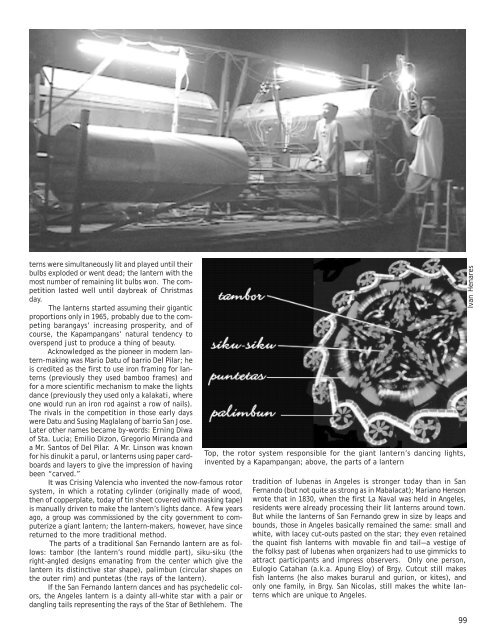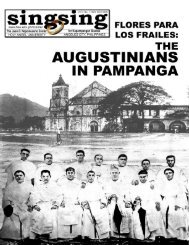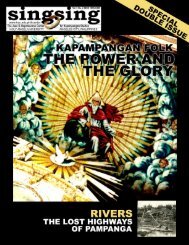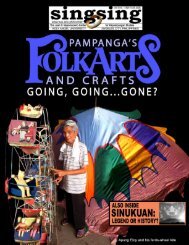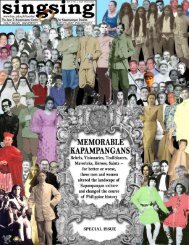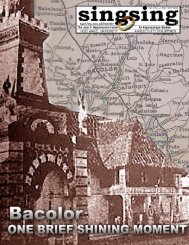Download PDF - Holy Angel University
Download PDF - Holy Angel University
Download PDF - Holy Angel University
You also want an ePaper? Increase the reach of your titles
YUMPU automatically turns print PDFs into web optimized ePapers that Google loves.
terns were simultaneously lit and played until their<br />
bulbs exploded or went dead; the lantern with the<br />
most number of remaining lit bulbs won. The competition<br />
lasted well until daybreak of Christmas<br />
day.<br />
The lanterns started assuming their gigantic<br />
proportions only in 1965, probably due to the competing<br />
barangays’ increasing prosperity, and of<br />
course, the Kapampangans’ natural tendency to<br />
overspend just to produce a thing of beauty.<br />
Acknowledged as the pioneer in modern lantern-making<br />
was Mario Datu of barrio Del Pilar; he<br />
is credited as the first to use iron framing for lanterns<br />
(previously they used bamboo frames) and<br />
for a more scientific mechanism to make the lights<br />
dance (previously they used only a kalakati, where<br />
one would run an iron rod against a row of nails).<br />
The rivals in the competition in those early days<br />
were Datu and Susing Maglalang of barrio San Jose.<br />
Later other names became by-words: Erning Diwa<br />
of Sta. Lucia; Emilio Dizon, Gregorio Miranda and<br />
a Mr. Santos of Del Pilar. A Mr. Linson was known<br />
for his dinukit a parul, or lanterns using paper cardboards<br />
and layers to give the impression of having<br />
been “carved.”<br />
It was Crising Valencia who invented the now-famous rotor<br />
system, in which a rotating cylinder (originally made of wood,<br />
then of copperplate, today of tin sheet covered with masking tape)<br />
is manually driven to make the lantern’s lights dance. A few years<br />
ago, a group was commissioned by the city government to computerize<br />
a giant lantern; the lantern-makers, however, have since<br />
returned to the more traditional method.<br />
The parts of a traditional San Fernando lantern are as follows:<br />
tambor (the lantern’s round middle part), siku-siku (the<br />
right-angled designs emanating from the center which give the<br />
lantern its distinctive star shape), palimbun (circular shapes on<br />
the outer rim) and puntetas (the rays of the lantern).<br />
If the San Fernando lantern dances and has psychedelic colors,<br />
the <strong>Angel</strong>es lantern is a dainty all-white star with a pair or<br />
dangling tails representing the rays of the Star of Bethlehem. The<br />
Top, the rotor system responsible for the giant lantern’s dancing lights,<br />
invented by a Kapampangan; above, the parts of a lantern<br />
tradition of lubenas in <strong>Angel</strong>es is stronger today than in San<br />
Fernando (but not quite as strong as in Mabalacat); Mariano Henson<br />
wrote that in 1830, when the first La Naval was held in <strong>Angel</strong>es,<br />
residents were already processing their lit lanterns around town.<br />
But while the lanterns of San Fernando grew in size by leaps and<br />
bounds, those in <strong>Angel</strong>es basically remained the same: small and<br />
white, with lacey cut-outs pasted on the star; they even retained<br />
the quaint fish lanterns with movable fin and tail—a vestige of<br />
the folksy past of lubenas when organizers had to use gimmicks to<br />
attract participants and impress observers. Only one person,<br />
Eulogio Catahan (a.k.a. Apung Eloy) of Brgy. Cutcut still makes<br />
fish lanterns (he also makes burarul and gurion, or kites), and<br />
only one family, in Brgy. San Nicolas, still makes the white lanterns<br />
which are unique to <strong>Angel</strong>es.<br />
Ivan Henares<br />
99


